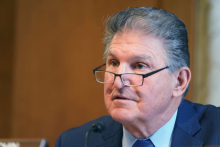
Economic justice organizers may soon triumph in their fight for a $15 minimum wage. Thanks to their years of effort, President Biden (and every Democratic contender during the primary debates) vowed to hike the minimum wage to $15 an hour. In keeping with that promise, Biden attached a wage bill to his $1.9 trillion COVID relief package.
Although Republicans and their political allies are firmly opposed to the measure, the Senate could approve it. But Democratic holdouts like West Virginia Sen. Joe Manchin could doom it, since he says $15 is too high for West Virginia and wants an $11 minimum instead. As almost a fifth of West Virginians live in poverty, a reasonable question would be: For whom is $15 too high?
This debate is not new. Since the early 1900s, businesses have balked at a livable minimum wage, while most others approve of it: According to recent polls, 75 percent of Americans want the minimum wage raised to $15. Even during the Great Depression, President Franklin Roosevelt struggled for six years before he convinced Congress to pass the Fair Labor Standards Act in 1938, which set the federal minimum at 25 cents an hour and 40 cents by 1940.
Furious at the Supreme Court and business interests for demolishing labor-friendly laws, FDR cautioned Americans to “not let any calamity-howling executive with an income of $1,000 a day … tell you … that a wage of $11 a week is going to have a disastrous effect on all American industry.”
Eighty years later, as of 2019, 34 million Americans still live at, under, or just above the poverty line; nearly half of workers earn under $15 an hour; and the federal minimum ($7.25 an hour) hasn’t budged since 2009.
For its part, the mainstream press isn’t helping. On February 11, a Washington Post editorial warned that, “Democrats must listen to the data,” claiming that “objective economic research” should convince Congress “to proceed with caution.”
So another question is whose data? For nearly 30 years, scores of scholars have reported on wage hikes’ positive effects: They pull the poor out of poverty and stimulate the economy by putting more cash in low-paid workers’ pockets, which they spend, boosting business receipts and raising tax revenues at all government levels.
But The Washington Post has fallen into FDR’s “calamity” camp, citing the supposedly nonpartisan Congressional Budget Office (CBO) data. On the plus side, in its latest report (February 2021), the CBO predicted that 27 million workers’ earnings would rise with a $15 minimum wage by 2025, lifting 900,000 Americans out of poverty. But it warned that, “1.4 million mostly young low-skilled workers would drop out of the labor force.” Equally grim, it claimed the federal deficit will soar by $54 billion over 10 years.
What’s little known is that the CBO doesn’t carry out its own studies and instead relies on others. And here’s the rub: According to Michael Reich, an economics professor at University of California, Berkeley, the CBO mainly looked at studies that found negative effects. Even worse, it kept spiking the damage, since its 2019 report said 1.1 million jobs would be lost — 300,000 fewer than its latest estimate.
Reich says the CBO based many of its figures on a University of Washington study, which found significant negative effects from Seattle’s 2014 minimum wage hike. However, the researchers redid the study in 2019 and found the effects were far smaller. But the CBO ignored the correction, and the Post did not alter its advice.
Citing his own research and studies from the Economic Policy Institute, Reich testified to Congress in 2019 that the $15 an hour wage would positively affect 32 million American workers. Also, he notes that while opponents claim that restaurants will have to raise prices and thus lose business, research shows that sales don’t drop. “This finding is based on a study of 27 metropolitan areas by two researchers at the Federal Reserve Bank in Boston and an MIT economist,” he says.
As to the deficit ballooning, Reich says the opposite is true: the hike will add $65 billion in revenues a year from low-wage workers’ payroll and income taxes. He adds that Arindrajit Dube, an economist at University of Massachusetts, Amherst, found that it will reduce government spending on food stamps as well as the child and earned-income tax credits, since more workers will be able to afford their groceries.
The first study on minimum wage hikes was done in 1992, when Princeton economists David Card and Alan Krueger looked at fast-food restaurant jobs — after New Jersey raised its hourly minimum wage from $4.25 to $5.05 and Pennsylvania did not. Opponents warned that New Jersey customers would take their business to Pennsylvania, and they’d need to cut their employees. But, based on the economists’ study of 410 restaurants, neither happened. “We find no indications that the rise in the minimum wage reduced employment.”
Reich adds that “many economists find that hikes to the minimum wage are fully passed on to restaurant customers and thus do not decrease the profits or sales. But the National Restaurant Association still remains opposed to minimum wages” — although retailers like Amazon and Costco advocate increasing them.
Today, 66,000 West Virginians earn less than the minimum wage, 16 percent live at or under the poverty line (which is $24,000 for a family of four), and the poverty rate for Black people in the state was 28.6 percent in 2018. One could infer Senator Manchin means a $15 minimum wage hike is too high for the state’s businesses. Perhaps he could be clued in about the needs of other West Virginians before he votes.
